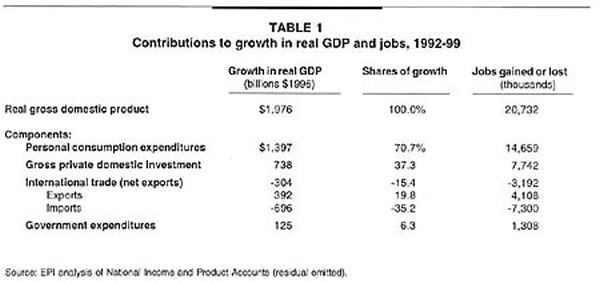Issue Brief #139
The Facts About Trade and Job Creation
by Robert E. Scott
It has become commonplace for public officials to claim that trade has contributed to job creation in the United States during the Clinton presidency. On March 8, 2000, Deputy U.S. Trade Representative (USTR) Richard Fisher argued that “We have created nearly 21 million new jobs nationwide since 1992, whereas Germany lost 700,000 jobs and Japan gained only 830,000….Trade is not the sole cause of this success, but it is a vital component.” Others have claimed that up to one-third of all jobs created have been due to the growth in exports.
From this, many people have inferred that the expansion of trade has had a positive affect on growth and jobs. This inference is incorrect. In fact, the effect of trade on growth and job creation during this expansion has been negative, not positive.
Trade includes imports as well as exports. Looking at exports while ignoring the effects of imports is like trying to keep score in a baseball game by adding up the runs scored by one team and ignoring those scored by the other. In this case, the score, i.e., the trade balance, is the difference between exports (which create jobs) and imports (which destroy them). If imports increase more rapidly than exports, as they have in this economic expansion, the net effect of trade will be to reduce growth and employment. Because of the expansion of domestic markets, however, overall economic growth and job creation has expanded despite the negative impact of recent trends in trade.
Trade, employment, and GDP growth
The U.S. Department of Commerce regularly publishes statistics on the contributions of major types of spending to real output (or GDP) growth. Table 1 summarizes the contributions to growth of all the components of GDP between 1992 and 1999: consumption, investment, international trade (exports minus imports), and government spending.

Real GDP increased by $1,976 billion between 1992 and 1999, as shown in the first column of the table. This represents a 28.7% expansion of GDP, or about 3.6% per year. The increase in each of the components of GDP is also shown in the first column. International trade (net exports) declined by more than $300 billion, in real terms, in this period, as the trade deficit expanded.
The growth in GDP is allocated to each of its components in the second column in the table, which calculates the share of GDP growth explained by each category of spending. The growth in personal consumption spending provided 70.7% of the increase in U.S. output in the current recovery. The growth in private domestic investment contributed an additional 37.3% of growth in this period. Government spending accounted for 6.3%.
The effect of international trade, however, was to reduce GDP by 15.4% since 1992. The growth of exports increased output by 19.8%, while the growth of imports reduced output by 35.2%.
There have been 20.7 million jobs created in the domestic economy since 1992. In the last column of the table, these jobs are allocated in proportion to the change in real output in each sector. These estimates show that, while rising exports created about 4.1 million jobs, rising imports lost 7.3 million, for a net effect of 3.2 million jobs lost due to trade.
While other techniques (such as the multiplier approach used by the USTR) may yield smaller estimates of the size of the trade effect, there can be no debate about the fact that trade has been a net destroyer of domestic jobs in this period.
Most trade is in the manufacturing sector, where wages in jobs related to both imports and exports tend to be higher than average wages in the economy. The net loss of manufacturing jobs due to trade has naturally had the effect of depressing U.S. wages in this period.
The most important effect of trade on the economy may be its role in moving labor out of one industry and into another, often from manufacturing to services. A total of 11.4 million workers – 8.9% of the total labor force in 1999 – have either gained or lost a job due to trade (the sum of jobs affected by imports and exports). Trade was costly for all workers who were forced to change jobs. The costs include lost wages due to unemployment, retraining and moving expenses, as well as the damage inflicted on their families and communities.
